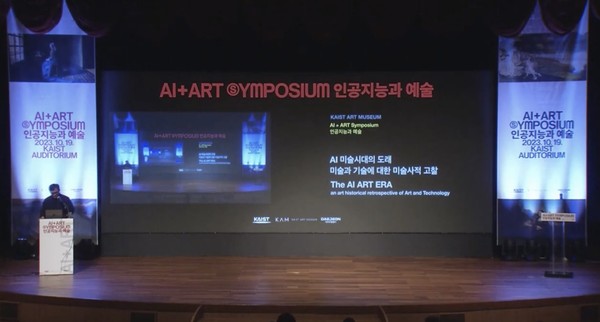With a commitment to the core values “Education, Exhibition, and Research,” the KAIST Art Museum hosted the “AI+Art Symposium'' to foster discussions on the fusion of AI and art on October 19. The event aimed to explore questions regarding the ownership of artwork, the intended audience, and the broader influence of AI on the arts within the context of cultural, social, and technological transformations.

To achieve this, the KAIST Art Museum, led by Director Hyunjeong Seok, invited 10 experts including scholars, researchers, curators, and critics from various backgrounds. Kay Watson, Senior Art Technology Manager at the Serpentine Gallery in the UK, delivered the opening keynote speech titled “Can Art Shape the Technologies of the Future?” She discussed how the Serpentine Gallery’s Art Technology program approaches AI-related work, emphasizing the interplay between art and technology.
The next lecture was given by Professor Yuk Hui from Erasmus University Rotterdam, who presented “Art at the Boundary of Artificial Intelligence,” connecting historical artistic roles during technological changes to the emergence of AI in the contemporary era. Subsequently, Jens Hauser from the Karlsruhe Institute of Technology discussed “Challenging Anthropocentrism in Art and AI: From Micro Performativity and Macro Effects to Un-Greening Greenness.” His presentation focused on debates surrounding ‘intelligence’ and ‘artificial’ in art, while also scrutinizing the symbolic use of ‘green’ from a scientific perspective.
The symposium continued with lectures by scholars currently actively engaged in both the art and technology fields. Professor Yiyun Kang from the Department of Industrial Design at KAIST explored “Immersive Art + AI” and showcased instances of multisensory art embracing AI as a resource for immersive storytelling. Following this, Professor Fumihiko Sumitomo from Tokyo University of the Arts presented “Technology for the Vulnerables,” discussing the role of art in a rapidly changing AI landscape.
Additionally, cases of technology-oriented art museums actively utilizing AI and learning tools were explored. First, Seong Eun Kim, Former Director of the Nam Jun Paik Art Center, introduced art projects under the theme “Play of De-control: Juggling with the Body and Data” and raised critical questions for museum curators. Moreover, Sukmo Kim, Director of the Sorol Art Museum, examined the historical relationship between technology and art in his lecture “The Advent of the AI Art Era: A Historical Examination of Art & Technology.” Furthermore, Jang Un Kim, Director of the Art Sonje Center, explored the perception of AI in the art world in his lecture “Recognizing AI in Art through Curatorial Approaches.”
The last lecture was given by Professor Sung-Pil Park, Dean of the KAIST Moon Soul Graduate School of Future Strategy, on the topic of “Challenges of AI-Generated Art on the Copyright System,” addressing legal issues related to AI-generated art.
The symposium concluded with a closing keynote speech delivered by Jinjoon Lee, Director of KAIST Art and Technology Center. The speech delved into the potential for AI to expand or restrict the range of human expression.
Director Hyunjeong Seok, who oversaw this symposium, expressed “I hope that this symposium, which aims to share insights and perspectives from experts who have extensively researched the roles of AI and art from various angles, will be a beneficial event for not only professionals in the field but also for the general public.”

